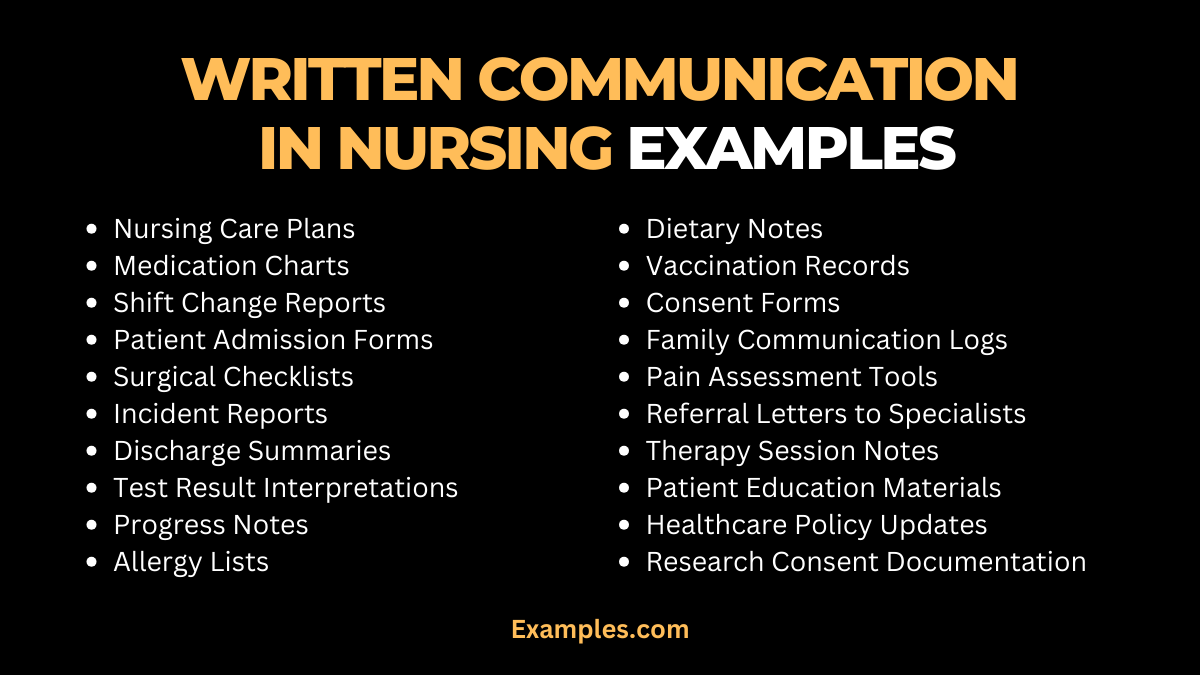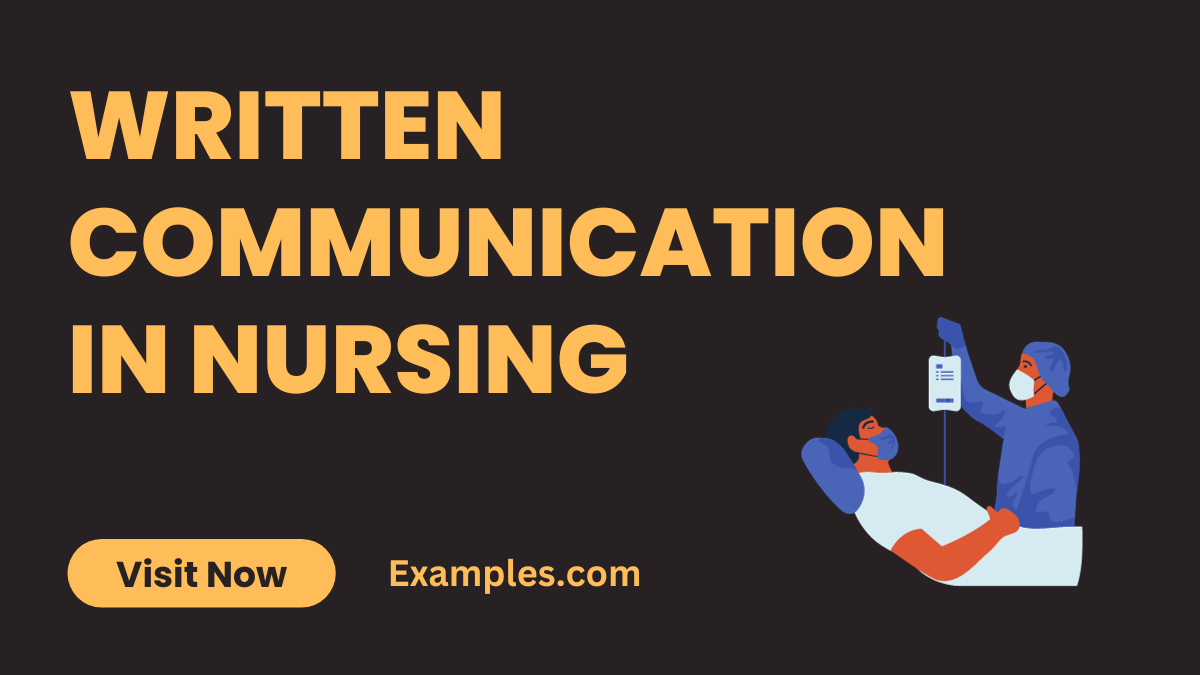19+ Written Communication in Nursing Examples
Discover the essentials of Written Communication in Nursing through our comprehensive guide. Delve into a range of Communication Examples, illustrating the pivotal role of effective documentation in healthcare. From improving patient outcomes to ensuring legal compliance, learn how clear and concise written records are fundamental in nursing practices. Embrace the power of quality communication to enhance care delivery and team coordination with our expert insights and actionable tips.
Download Written Communication in Nursing Examples PDF
What is Written Communication in Nursing? – Meaning

Written communication in nursing is the systematic recording of patient care and related interactions by healthcare professionals. It includes various forms of documentation such as nursing notes, medical charts, and care plans. This communication method is critical for providing high-quality care, ensuring continuity among healthcare team members, and maintaining legal records of patient treatment and progress.
What is the Best Example of Written Communication in Nursing?

The best example of written communication in nursing is often considered to be the patient care report or the nursing notes. These notes provide a comprehensive and continuous record of a patient’s condition, treatments, responses, and progress. They are crucial for communicating vital information among the care team, aiding in decision-making, and providing evidence of care provided. Good nursing notes are detailed, clear, accurate, and timely, reflecting all aspects of patient care.
20 Written Communication in Nursing Examples

In the realms of schools, education, and the classroom, effective written communication is crucial. It ensures clarity, accuracy, and continuity of care. By understanding what causes lapses in this critical skill and adopting strategies on how to Improve Written Communication, healthcare professionals can significantly enhance patient outcomes and teamwork.
- Nursing Care Plans: Detailing patient care, causes include lack of detail or misunderstanding of patient needs. Improvement comes from thorough assessments and clear writing.
- Medication Charts: Essential for accurate drug administration, errors often arise from hurried entries. Double-checking and clear handwriting can fix this.
- Shift Change Reports: Miscommunications can occur during shift changes, leading to errors. Standardized templates and clear, concise language improve these transitions.
- Patient Admission Forms: Incorrect patient data can lead to severe consequences. Staff training and meticulous review processes can enhance accuracy.
- Surgical Checklists: Essential for pre-operative procedures, mistakes often due to oversight. Adherence to checklist protocols and teamwork can mitigate errors.
- Incident Reports: Documenting adverse events or errors, often caused by haste or stress. Encouraging a culture of detailed, non-punitive reporting can improve quality.
- Discharge Summaries: Sometimes vague or incomplete, leading to patient confusion post-discharge. Ensuring completeness and patient understanding fixes this issue.
- Test Result Interpretations: Misinterpretation can occur due to complex medical terminology. Regular training and clear, simplified explanations for patients are key.
- Progress Notes: Vague or incomplete notes can lead to misinformed decisions. Continuous education and a focus on detail enhance these notes.
- Allergy Lists: Errors often from outdated or incomplete information. Regularly updating and verifying with patients improve accuracy.
- Dietary Notes: Miscommunications can lead to incorrect meal provisions. Clear, specific instructions and double-checking with dietary services are essential.
- Vaccination Records: Inaccuracies due to oversight or confusion. Maintaining up-to-date and thorough records prevents errors.
- Consent Forms: Misunderstandings often arise from medical jargon. Simplifying language and verifying patient understanding can alleviate issues.
- Family Communication Logs: Miscommunications with family can occur. Ensuring detailed and empathetic entries improves relationships and care.
- Pain Assessment Tools: Sometimes subjective or misunderstood. Regular training and patient interaction improve accuracy.
- Referral Letters to Specialists: Vague referrals can lead to diagnostic delays. Specific and detailed referrals enhance patient care.
- Therapy Session Notes: Omissions or vague descriptions can hinder therapy. Detailed, reflective notes improve treatment outcomes.
- Patient Education Materials: Misunderstanding due to complex terms. Clear, simple language and visuals enhance understanding.
- Healthcare Policy Updates: Confusion from lack of engagement. Regular updates and staff discussions ensure compliance.
- Research Consent Documentation: Misunderstandings often from legal terminology. Simplified explanations and patient dialogue improve understanding.
Written Communication in Nursing Techniques
Explore the pivotal Written Communication in Nursing Techniques that bridge gaps in healthcare delivery. Effective communication is the backbone of nursing, ensuring clarity, continuity, and quality of patient care. Dive into techniques that enhance Written Communication in the Workplace, specifically tailored to nursing and broader healthcare settings, including practical applications in schools for aspiring healthcare professionals.
- Structured SOAP Notes: Streamline patient info for efficiency.
Assessment should state patient changes clearly. - Electronic Health Records (EHR) Usage: Use EHRs for real-time, accurate documentation.
Update EHRs after any treatment to keep records current. - SBAR Technique: Use SBAR for focused team communication.
Begin with ‘Situation’ to inform the team of the patient’s state. - Visual Aids in Patient Education: Use charts to explain complex conditions.
Incorporate a heart diagram to illustrate cardiac issues. - Checklists for Routine Care: Ensure comprehensive care with checklists.
Initial completed tasks for accountability.
Written Communication in Nursing for Assignment
Master Written Communication in Nursing for Assignment, crucial for students and professionals. It encompasses Classroom Assignments, essays, Class Notes, and discussions conducted through written forms. Effective Written Communication Sentence Examples enhances learning, fosters critical thinking, and encourages expression, playing a crucial role in modern education. Assignments require articulation and precision, integrating Written Communication in Healthcare, and applying it in nursing, workplace, and schools.
- Case Study Summaries: Develop summaries focusing on care strategies.
Summarize condition, treatment, and interventions in case studies. - Care Plan Rationales: Provide rationales for nursing interventions.
Articulate rationales for interventions, citing sources. - Reflective Journals: Encourage reflective practice through journaling.
Detail lessons learned from care experiences. - Research Article Critiques: Critique nursing research for critical understanding.
Discuss methodology and findings of nursing articles. - Policy Proposal Documents: Advocate for nursing practice improvements.
Detail expected outcomes and benefits of hospital policy changes.
What is the Importance of Written Communication in Nursing?
Importance of Written Communication in nursing is pivotal for patient safety, care continuity, and legal compliance. It’s a foundational skill across various settings, including Written Communication in Schools, where future healthcare professionals begin their training.
- Ensures Accurate Patient Records: Maintains comprehensive and accurate details of patient care and history.
- Facilitates Interdisciplinary Collaboration: Essential for team-based care and ensuring all healthcare providers are informed.
- Legal and Professional Accountability: Acts as a legal document for care provided and decisions made.
- Enhances Patient Education: Vital for explaining conditions and care plans to patients and families.
- Improves Healthcare Quality: Directly impacts the quality and safety of patient care through clear, concise information.
What are the Types of Written Communication in Nursing?
Understanding the types of written communication is key to effective education and practice in nursing. This insight is crucial not only in clinical settings but also for enhancing Written Communication in the Classroom.
- Nursing Notes and Journals: Personalized notes detailing patient care and observations.
- Care Plans: Structured documents outlining the strategies and goals for patient care.
- Incident Reports: Documentation of any unusual or unexpected events affecting patient care.
- Medical Histories: Comprehensive records of patient’s past health conditions and treatments.
- Discharge Summaries: Overviews of the patient’s hospital stay and instructions for home care or follow-up.
What are the Benefits of Written Communication in Nursing?
The benefits of written communication in nursing underscore its role in enhancing patient care and professional practice. Underlining the need to continually improve written communication and understand the Characteristics of Written Communication for better patient outcomes and professional excellence. This is increasingly taught and valued in Written Communication in Education, preparing students for real-world healthcare environments.
- Improves Patient Care Continuity: Ensures seamless care transitions between shifts and providers.
- Enhances Professional Development: Encourages nurses to be more observant, detailed, and reflective in their practice.
- Reduces Errors: Clear, detailed communication minimizes the risk of misunderstandings and errors.
- Promotes Patient Safety: Detailed records help in identifying patterns, preventing complications or errors.
- Facilitates Research and Education: Serves as a resource for case studies, training, and quality improvement initiatives.
How is Written Communication Used in Nursing?
Written communication in nursing is used to document patient care, facilitate teamwork, and ensure continuity of services. It’s vital for quality healthcare, as evidenced by Written Communication Examples and Written Communication Journals.
What is Written Communication in Health Care?
In healthcare, written communication involves documenting patient information, treatment plans, and medical histories to ensure effective and safe care delivery. Its importance and characteristics are fundamental to patient outcomes.
In conclusion, written communication in nursing is integral to delivering quality care. Through detailed sentence examples and comprehensive journals, it’s evident that effective documentation ensures patient safety, enhances team coordination, and fosters continual learning. Embracing these practices is essential for any healthcare professional committed to excellence in patient care.



